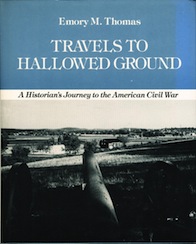Thomas’s Travels to Hallowed Ground a ho-hum travel partner
 “Historian travels to battlefields and writes about his experiences.” Sounds right up my alley. After all, I do a lot of that for Emerging Civil War, and my dissertation is going to take me in that direction, so it’s always interesting to see how other people do it.
“Historian travels to battlefields and writes about his experiences.” Sounds right up my alley. After all, I do a lot of that for Emerging Civil War, and my dissertation is going to take me in that direction, so it’s always interesting to see how other people do it.
That’s how a professional colleague of mine described Emory Thomas’s Travels to Hallowed Ground. He recommended it to me particularly because Thomas takes his son on some of his journeys, and my colleague knew that I got into battlefielding because of my daughter. Thomas’s book, then, might potentially offer some interesting ways at looking at the fields.
Thomas has a long career as a Civil War historian, with biographies of Confederates Robert E. Lee and JEB Stuart as his most notable books. He’s retired now, and to the best of my knowledge, hasn’t made a cottage industry out of tour-guiding the way a lot of the other “lions” of the field have done. If he had some thoughts inspired by visits to battlefields, I figured they’d be worth reading.
I was disappointed with the last such book I looked at, though: James McPherson’s Hallowed Ground: A Walk at Gettysburg. It turned out to basically be McPherson’s excuse to write about the battle—which was, no doubt, an excellent account. But as a first-person presence in the book, he didn’t add much in the way of personal reflections or insights. He was almost superfluous in that respect (his history, and his narrative were great, though, so my disappointment only stems from what I was expecting, not from the quality of McPherson’s work).
Thomas does no better, although rather than take an extended look at a single battle, he provides shorter explorations of several battles. Each chapter is the length of a typical magazine article (and, indeed, some appeared in Civil War magazines in the mid-80s). There’s no real common thread that connects the chapters, though, other than the fact that Thomas visited there.
And for the record, his son goes on only one journey—so any hopes I had of father-child bonding experiences were pretty much shot. They travel to Roanoke Island—home of the infamous “Lost Colony” of English settlers who vanished long ago. Thomas and his son went there, though, to check out Burnside’s successful capture of the North Carolina coastal defenses. They discovered that not much had been preserved (such is still the case today). “What did you expect?” his son asks at the end, the long set-up to joke that’s not as clever as it thinks it is. “When you go looking for the remains of a battle like Roanoke Island, the most appropriate thing you can find is nothing.”
Thomas arranges his essays in chronological order, but there are such vast gaps in the chronology that their order seems almost moot. He skips most major battles, which I kind of liked, and visited some out-of-the-way places, which I also liked.
He doesn’t quote much primary-source documentation but rather just synthesizes it all into his narratives, which read like summaries. It might, therefore, seem like the book would then lend itself as a good source for a beginner who wants a general overview of things, not too in-depth, but because Thomas leaves out so many of the war’s biggest events, his book wouldn’t be too useful for the novice. The buff, meanwhile, is going to know most of this already. The one thing he could bring to the table—his own insights and reflections—must’ve gotten left in the car as he was driving around.
The one exception is his second-to-last chapter, which focuses on an ethics-related issue from Petersburg. A photographer took a picture of a Confederate soldier’s corpse, with entrails hanging out, and copies of the photo because widely popular as a stereoscopic image in parlors across the country. Basically, a camera with two lenses, side-by-side, snapped the same picture, but because of the slightly different angles, when viewed through a stereoscope device, the images created a 3-D effect for viewers. They were all the range in the 1860s.
“That the dead young soldier and his three-dimensional entrails became items of entertainment only adds obscenity” to the lesson that “war is meaningless butchery,” Thomas says, obviously disturbed by the episode. In the 80s, with threats of nuclear annihilation still hanging over us, Thomas wondered if people would ever learn. “The human experience of history seems to show that if we are to survive, to avoid nuclear holocaust, we must do something more than watch television,” he says.
While that piece provided an excellent takeaway, the rest of the book was modest. I’m not sure it was worth the effort to track it down (since it’s out of print).
————
cross-posted at Scholar & Rogues
2 Responses to Thomas’s Travels to Hallowed Ground a ho-hum travel partner